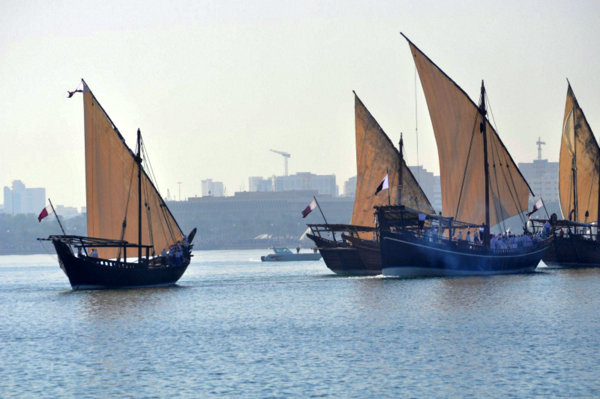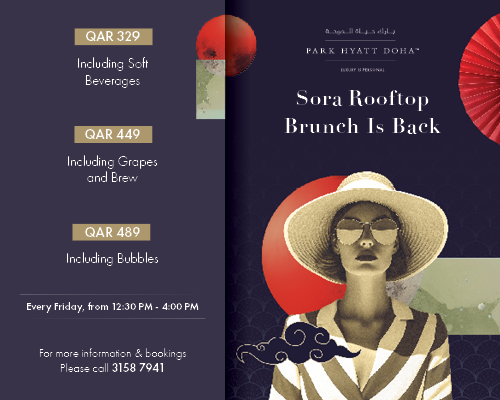Dhow is the generic name for a number of traditional sailing vessels with one or more masts with lateen sails used in the Red Sea and Indian Ocean region. Some historians claim the dhow was invented by Arabs or Indians. Typically sporting long thin hulls, dhows were trading vessels primarily used to carry heavy items, like fruit, fresh water or merchandise, along the coasts of the Arab countries, Pakistan, India, Bangladesh and East Africa. Larger dhows have crews of approximately 30, smaller ones typically around 12.
The exact origins of the dhow are lost to history. Most scholars believe that it originated in China between 600 BCE to 600 CE. Some claim that the sambuk, a type of dhow, may be derived from the Portuguese caravel. Unfortunately, there is almost no pictorial evidence of early dhows. Most of our knowledge of the dhow’s early construction comes to us from the records of Greek and early Roman historians. Added to this, we can compare some similar hull constructions used in the later Roman period, after they had the opportunity to learn from Arab sailors. Dhow making is considered an art, and this art has been passed down from one generation to another, preserving, at least in part, the dhow’s basic design and use.
Even to the present day, dhows make commercial journeys between the Arabian Gulf and East Africa using sails as their only means of propulsion. Their cargo is mostly dates and fish to East Africa and mangrove timber to the lands in the Gulf. They often sail south with the monsoon in winter or early spring, and return in late spring or early summer.
Despite their historical attachment to Arab traders, dhows are essentially an Indian boat, as much of the wood for their construction came from the forests of India.
In Europe, boat names are based on the type of sail rigging the boat has. Thus, it is typical for Europeans to label all Arab boats as dhows. In the Middle East however, boats are classified according to the shape of their hull. Therefore, dhows with square sterns have the classifications gaghalah, ganja, sanbuuq, and jihaazi. The square stern is basically a product of European influence, since Portuguese and other boats visited the Gulf from the 16th century.
Older type vessels are now called buum, zaaruuq, and badan, and still have the double-ended hulls that come to a point at both the bow and the stern.
The generic terms for ship in Arabic is markab and safiinah. Fulk is used in the Qur’an. The word daw is Swahili, and was not used by the Arabs, although it was popularised by English writers in the incorrect form of dhow.
The dhow was known for two distinctive features. First of all, its triangular or lateen sail, and secondly, for its stitched construction. Stitched boats were made by sewing the hull boards together with fibres, cords or thongs.
The idea of a boat made up of planks sewn together seems strange, though this type of construction was popular in many parts of the world and in some places still is. In the Indian Ocean, it dominated the waters right up to the 15th century, until the arrival of the Portuguese brought in European methods. A Greek sea captain or merchant who wrote in the 1st century CE reports the use of small sewn boats off Zanzibar and off the southern coast of the Arabian Gulf. Marco Polo saw sewn boats at Hormuz at the entrance to the Arabian Gulf. He took a dim view of them: ‘they were twine and with it stitch the planks of the ship together. It keeps well and is not corroded by seawater but it will not stand well in a storm.’
Later travellers reported seeing large sewn boats of 40 and 60 tonnes and versions fairly large in size were still plying the waters of East Africa and around Sri Lanka in the early decades of the 20th century.

History of the dhow
According to Hourani, a British-Lebanese historian, fully stitched construction was observed by medieval writers in the Red Sea, along the east African coast, in Oman, along the Malabar and Coromandel Coasts of India, and in the Maldives and Laccadive Islands.
The characteristics of pre-European influence, ocean-going Indian ships based on pictorial evidence were double-ended craft. Prior to the 11th century CE, the stern was raked, but after that time, a long projecting bow became the predominate characteristic. Hull planks were flush-laid and stitched with the stitches crossed and penetrating right through the planks.
Procopius, a Greek scholar, writing in the 6th century CE, tells us that ships used in the Indian Seas ‘are not covered with pitch or any substance, and the planks are fastened together, not with nails but with cords.’
Some illustrations of stitching can be found in Sanchi sculptures of the 2nd century BCE, and paintings accompanying Al Harari’s Maqamat of 1237 CE. The 13th century CE account of Marco Polo is less than complimentary: ‘The vessels built at Hormuz are the worst kind, and dangerous for navigation, exposing the merchants and others who make use of them to great hazards.’
Masts and sails
In early times the masts and yards were probably made of coconut wood and teak, although a number of woods were used in later construction. It is thought that originally sails were woven from coconut of palm leaves, and that eventually cotton cloth became the favourite for merchants on long voyages. Cotton cloth was manufactured in India. Two main sails were carried, one for night and bad weather, and the other for day and fair weather. Sails on a dhow could not be reefed (rolled up).
The lateen sail used by Arabs stops short of being completely triangular. Their sails retained a luff (the edge of a fore-and-aft sail next to the mast or stay) at the fore part in proportion to the leech (slide of a sail) of roughly 1–6 in the mainsail. The retention of this luff added a much greater area of sail to be hoisted than would a completely triangular design. During the Byzantine era the lateen sail completed its evolution into a triangle, and this idea spread from Byzantium to the rest of Europe, where it developed into the varieties of mizzen sails which later gave European sailing ships so much flexibility. From there it was eventually developed in the West into all the types of fore-and-aft rig known to yachtsmen today, a form superior still to the lateen for sailing close to the wind.
It is assumed by some that the lateen sail developed on the Red Sea, and spread from there to the Mediterranean Sea and Arabian Gulf. There is some evidence that a fore-and-aft lateen rig arrived in the Aegean Sea in the 2nd century, and in the Arabian Gulf around this time.
The masts and rigging were similar in all types of dhows, with added rigging in larger vessels. Masts were secured at the base by being slotted into a mast step, which fit over the floor timbers. Cables were often made of coir.
Sails
The lateen sail on the dhow looks triangular to the casual observer, but in fact it is quadrilateral and is correctly termed a settee sail. It was made of several pieces of cloth, sewn parallel to luff and leech. Different types of sail were made according to requirements: a sail wanted for reaching would be made less flat and with a fuller luff than a sail wanted for beating.
Dhow shipbuilding is a very ancient trade. In various places around the world, shipbuilding techniques and styles developed until they were successful. Once they reached this stage, schools of shipbuilding, with their various skills and knowledge solidified certain styles of boats. These styles changed very slowly over the centuries as ship building techniques were often closely guarded secrets. Ship builders took pride in their particular style of building.
Thus, three styles of ships developed in the ancient world. On the Mediterranean, triremes and trade boats shared similar styles, with small square sails, and outboard steering oars. On the Indian Ocean, dhows, with their triangular sails and stitched hull design dominated the waters. On the China seas, Chinese junks, with their tall forecastles, multiple masts, and unique sail rigging and sternpost rudder existed for centuries.
Each of these seas was separated from the other, some by landmasses, and some by dangerous straits and massive cultural differences. Bridging the gaps between these civilisations were other smaller civilisations that daringly took goods and knowledge from one sphere to the other. In the Arabian Gulf, the Nabataeans played this role. In Asia, sailors with their lashed-lug (four-sided fore-and-aft sail) ships seemed to have played this role.
It was only when shipbuilders saw a proven improvement that they would adapt it into their own design. Ship design changed very slowly over time, allowing us to fill in the gaps in shipbuilding knowledge, but looking at previous designs and later designs. Changes in shipbuilding technique also point to nautical contacts between these three great shipbuilding spheres. Added to this, it must be accepted that many if not most dhows were built in India, and sold to Arab traders. Whatever the case, dhows were the preferred boat for transporting cargos on the Indian Ocean, and they dominated this scene for almost two thousand years.
[accordion][acc title=”Experience a traditional dhow cruise off Doha’s Corniche”]To take in the Doha skyline, a gorgeous sunset and enjoy some time out at sea, consider taking a dhow cruise around Doha Bay, with a stop at the island in the middle of the bay. The dhows generally leave from the jetty near Al Mourjan restaurant on the Corniche. Dhows can also be hired for parties and other private events. Tour companies offer three- to four-hour evening dhow cruises with dinner, traditional music and entertainment for around QR330–500 per person. For local tour companies see Sightseeing in Discovering Qatar. [/acc][/accordion]
Author: Sarah Mascarenhas
Note: This article has been extracted from Marhaba’s Issue No 61 Winter 2014/15 from the ‘Special Features’ section. For more information about Qatar, pick up Marhaba’s Issue No 61 for only QR20 from the nearest hypermarket or bookstore to you.
Copyright © Marhaba Information Guide. Reproduction of material from Marhaba Information Guide’s book or website without written permission is strictly prohibited. Using Marhaba Information Guide’s material without authorisation constitutes as plagiarism as well as copyright infringement.







